
An effective marketing strategy includes learning how to construct an easy-to-understand social media analytics report. Having all of your data in one place allows you to see how far you've come and make changes depending on your results.

Apr 18 2024 ● 8 min read

However, manually preparing a report takes a long time, raising the question of whether this is the ideal way to track your progress.
It has been established to be the most concrete, data-driven manner of demonstrating your accomplishments. So, how do you create a social media report without wasting a lot of time? What types of social media metrics and KPIs should you include? How often should the results be checked? In today's article, you'll discover how to create a social media report and use social media data to your advantage.
Social media analytics refers to the process of pulling data from social media channels and analyzing digital marketing efforts and account performance. You’d usually need a social media analytics tool to gather and create reports for the ideal optimization process.
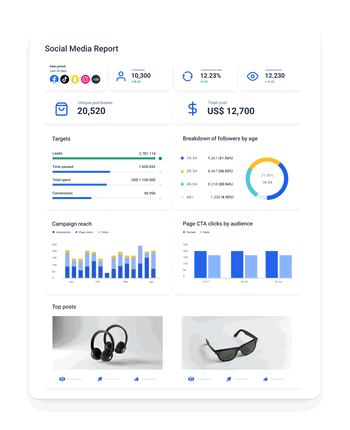
But if you've ever seen a social media marketing report, you know how frustrating it can be: the data sets might be so large that you don't even want to read it - and for those less-data-savy, may be hard to understand. That isn't to imply that data reports aren't important. You can benefit from a social media report in the following ways:
Keep in mind that your report should be well-organized and attractive to the eye. Otherwise, it'll just be a burden in your teammates' eyes.
A social media report is a document that compiles real-time and historical data points from relevant social networks (Instagram, Facebook, or Twitter). These reports examine the progress of your social media activities and provide key metrics as well as actionable insights.
How often to create these reports?
Of course, it depends on your client's needs and the size of your marketing campaigns. Here's what to expect from each type of report, based on its frequency:
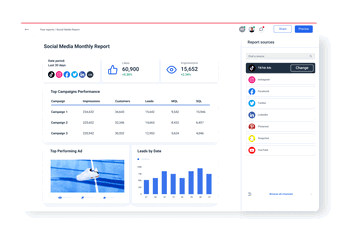
Extra tip: although report frequency is essential, make sure you’re tracking growth, too. To do it, you can compare the previous report to your current one.
Depending on your aims and resources, each social media report will be different. We've compiled a few questions to ask yourself to help you pick which KPIs to include in your report:
1. Who is my target audience?
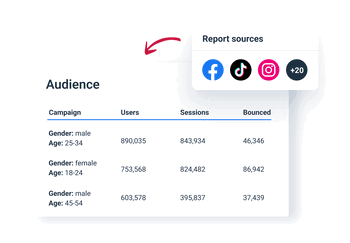
2. Is there any specific information relevant in this context?
3. Are you reviewing a particular campaign or ongoing results?
Now, keep your answers in mind throughout the entire process of creating your social media report.
Start with the introduction: lay down your goals, tactics, and metrics. This way, your readers will get a general overview of what this report will be about.
Also, provide a brief performance summary. Include critical details, like the number of new followers or leads generated. In other words, be sure to mention the highlights of your campaign.
When it comes to building a social media insights report or dashboard, there are several key things to consider. Now you’ll find a list of essentials to go through before even drafting a report.
When deciding what metrics you should add to the report, consider your goals and objectives. Here are the most common numbers social media marketers track:
It would help if you considered including data that generates money for your client, such as the number of leads, conversions, the total revenue, or ad spend. Of course, feel free to add any further information if you think it’s relevant to your campaign or strategy.
When it comes to developing social media monitoring reports, establishing and evaluating the relevant KPIs isn't the only element to consider. Always strive to look at your data from different angles, to examine and filter your data for hidden insights that could help you improve your performance.
Combining data from multiple social media sources gives you a holistic view of your marketing efforts, leading to more meaningful insights and better decision-making.
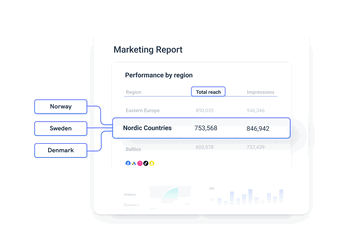
For example, you can combine data to gauge the performance by region for any of your channels. Let’s say, you want to see unified campaign results for the Nordic region. Whatagraph’s Organize feature allows you to quickly group metrics like Reach and Impressions from different countries into tiers.
This feature is not limited just to countries. You can aggregate your social media data by campaign, year, audience, age, etc.
However, the capabilities of data transformation don’t stop there. By integrating data from different channels and platforms and performing a cross-channel analysis, you can have a unified view of user interactions across various social media channels, which helps you optimize your marketing strategy.
Finally, data blending allows you to create custom reports and dashboards that meet specific analytical requirements — for example, having data from multiple sources visualized in the same table widget or unifying names of dimensions and metrics from different platforms.
The amount and diversity of data generated by your social media initiatives will be significant if you use multiple platforms. This becomes especially difficult to manage when you're tracking multiple platforms, for multiple clients.
Whatagraph is a great marketing analytics tool, that can aggregate massive amounts of data from all channels and make it simple to understand for all involved.
Data visualization is an important feature of these reports because it simplifies data analytics and saves time.
Some posts become viral right away, while others take some time to reach the ideal number of impressions. However, the most crucial thing is that you and your clients always stay on top of social media performance metrics.
It would be ideal to use Whatagraph to automate reports at regular intervals (as mentioned above) and remove manual reporting.
There are a plethora of SaaS reporting options on the market today. Only a few, however, include a user-friendly panel, data visualization, and automation features.
Whatagraph is a marketing analytics reporting solution that has not only the mentioned features but also white-label, cross-platform reporting, and a pre-made template library.
Here’s how to gather the analytics on different social media platforms:
To gather Instagram performance data for your Instagram analytics report, make sure you are using a business account. Also, you’ll only be able to acquire this information using the application on a mobile device.
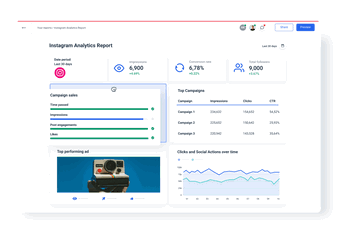
Open your profile and tap the Insights button. Alternatively, you can click the settings icon in the upper-right corner and select Insights. Instagram Insights can be split into three sections: content, activity, and audience. While you’re in the Insights section, gather impressions and engagement rates. When you're here, you can siphon off the data and make your very own Instagram Insights report using a tool or a simple spreadsheet.
To access Facebook Page Insights, first, open your Facebook Page. Then, navigate to the top menu and select Insights. If you can’t find Insights in the menu, click More to bring it up: you’ll be taken straight to your Overview. You’ll be able to access the Overview anytime by clicking it in the left-hand menu. Try using a Facebook Ads Reporting Tool to build more detailed client reports.
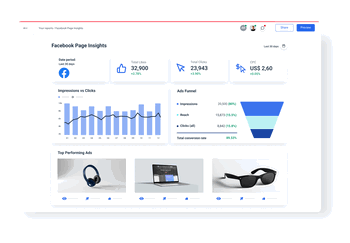
To create a Twitter Analytics report, start by logging in to your Twitter account at analytics.twitter.com. If you’re using the mobile Twitter application, tap the analytics icon visible in your Tweets.
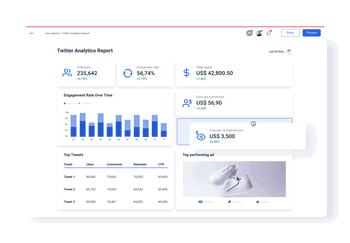
On desktops, click on an individual tweet to see its data. On mobiles, tap the Tweet to see the Tweet detail page, and then click View Tweet activity: here, you’ll see all the necessary numbers.
These are just the three most common social media platforms. If you’re also using Pinterest, LinkedIn, or other channels, make sure to acquire data from there, too.
Dashboard and reporting tools - like Whatagraph for example - can gather all of these critical social media marketing metrics automatically, for all of your clients and aggregate them in one place!
If you decide to make a Whatagraph account, just connect your social media platforms with Whatagraph, and all of the latest analytics and insights will be included without any additional input. At this point, all you will have to do is drag-and-drop the metrics you wish to include within the report and you're all set.
Now that you’ve collected the necessary information, it’s time to start working on your presentation. Reading a ton of data is already tricky, so here’s your chance to make it easier. Your report should be visually appealing yet still cover relevant information. Here are a few general tips to make the data easier to understand:
You can present the information in many ways: for instance, a simple slide might do the trick. But, wouldn’t it be great if there was someone (or something) that did all these things for you? Yes, the data gathering, the right metric picking, the visualizing.
Luckily, there is.
Whatagraph is software that builds social media performance reports for you. The tool gathers and visualizes the key performance indicators in one place. You can create the report from scratch or use pre-made templates and widgets. Either way, the tool allows you to compare metrics from different channels, all in a single sheet.
As a matter of fact, we even made a social media report template for you to use! It's highly customizable so you can adapt the template to the individual needs of your firm or your clients. Give it a try.
Published on Feb 03 2020